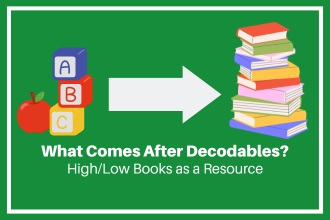What Comes After Decodables? High/Low Books as a Resource
As educators and curriculum specialists, we understand the importance of providing students with the right tools to foster their reading development. Decodable books have long been a staple in literacy instruction, offering early readers the opportunity to practice phonics skills in context. But what comes next after mastering phonics? Enter high/low books—a valuable resource that bridges the gap between decoding and comprehension, offering a multitude of benefits for students at various reading levels.
Understanding High/Low Books
High/low books, also known as high-interest, low-reading level books, are precisely what their name suggests—texts that feature engaging content at a readability level accessible to struggling or reluctant readers. These books are designed to cater to students who may have mastered basic decoding skills but still require support in building fluency and comprehension.
The Benefits of High/Low Books
Engagement: High/low books captivate students with topics and themes that resonate with their interests and experiences. By offering engaging content, these books motivate students to actively participate in reading and develop a love for literature. For example, Minecraft, browseable facts books, and genre fiction all do a great job of engaging readers based on their other interests outside of reading.
Building Fluency: Reading fluency—the ability to read with accuracy, speed, and expression—is a crucial component of literacy development. High/low books provide repeated opportunities for students to practice reading smoothly and with expression, ultimately improving their fluency skills.
Expanding Vocabulary: Through exposure to diverse vocabulary and context clues, high/low books help students expand their word knowledge and comprehension skills. By encountering new words in meaningful contexts, students develop a deeper understanding of language and enhance their overall literacy skills.
Boosting Confidence: For struggling readers, success breeds confidence. High/low books offer manageable challenges that allow students to experience success in their reading endeavors. As students progress through these texts, they build confidence in their abilities and develop a positive attitude towards reading.
Fostering Comprehension: While decodable books focus primarily on decoding skills, high/low books shift the emphasis to comprehension. These texts challenge students to think critically, make inferences, and draw conclusions—all essential skills for becoming proficient readers.
Integrating High/Low Books into Curriculum
Incorporating high/low books into your curriculum is a strategic approach to supporting diverse learners in their literacy journey. Consider the following tips for effectively integrating high/low books into your instruction:
Assess Students' Reading Levels: Conduct regular assessments to determine students' reading levels and select high/low books that align with their abilities and interests.
Provide Scaffolded Support: Offer scaffolding support, such as pre-reading activities, vocabulary instruction, and comprehension strategies, to help students navigate high/low texts successfully.
Promote Independent Reading: Encourage independent reading by providing access to a variety of high/low books in classroom libraries or through digital platforms. Allow students to choose books that pique their interest and empower them to take ownership of their reading journey.
Integrate Across Subjects: Explore opportunities to integrate high/low books across different subject areas, such as science, social studies, and history. By incorporating content-rich texts, you can reinforce learning and engage students in interdisciplinary exploration.
High/low books offer a wealth of benefits for students beyond the phonics stage, providing engaging content, building fluency and vocabulary, boosting confidence, and fostering comprehension skills. By strategically integrating high/low books into your curriculum, you create a supportive learning environment that meets the diverse needs of all learners and cultivates a lifelong love of reading.
Looking for ways to incorporate high/low titles into your curriculum, or support struggling and reluctant readers in pleasure reading? One of our literacy specialists will be happy to build you a custom list!

